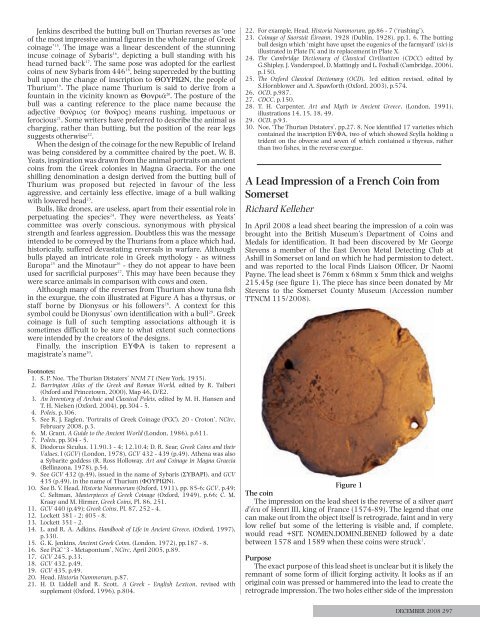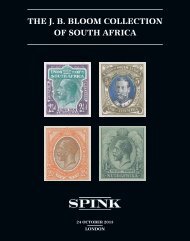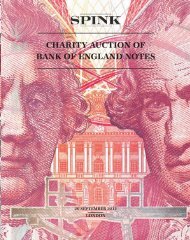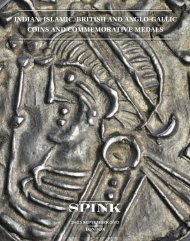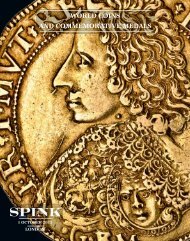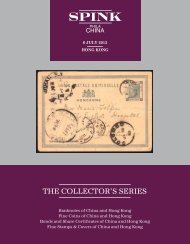Download PDF - Spink
Download PDF - Spink
Download PDF - Spink
- No tags were found...
You also want an ePaper? Increase the reach of your titles
YUMPU automatically turns print PDFs into web optimized ePapers that Google loves.
Jenkins described the butting bull on Thurian reverses as ‘oneof the most impressive animal figures in the whole range of Greekcoinage’ 15 . The image was a linear descendent of the stunningincuse coinage of Sybaris 16 , depicting a bull standing with hishead turned back 17 . The same pose was adopted for the earliestcoins of new Sybaris from 446 18 , being superceded by the buttingbull upon the change of inscription to ΘΟΥΡΙΩΝ, the people ofThurium 19 . The place name Thurium is said to derive from afountain in the vicinity known as Θονριά 20 . The posture of thebull was a canting reference to the place name because theadjective θον´ριος (or θονˆρος) means rushing, impetuous orferocious 21 . Some writers have preferred to describe the animal ascharging, rather than butting, but the position of the rear legssuggests otherwise 22 .When the design of the coinage for the new Republic of Irelandwas being considered by a committee chaired by the poet, W. B.Yeats, inspiration was drawn from the animal portraits on ancientcoins from the Greek colonies in Magna Graecia. For the oneshilling denomination a design derived from the butting bull ofThurium was proposed but rejected in favour of the lessaggressive, and certainly less effective, image of a bull walkingwith lowered head 23 .Bulls, like drones, are useless, apart from their essential role inperpetuating the species 24 . They were nevertheless, as Yeats’committee was overly conscious, synonymous with physicalstrength and fearless aggression. Doubtless this was the messageintended to be conveyed by the Thurians from a place which had,historically, suffered devastating reversals in warfare. Althoughbulls played an intricate role in Greek mythology - as witnessEuropa 25 and the Minotaur 26 - they do not appear to have beenused for sacrificial purposes 27 . This may have been because theywere scarce animals in comparison with cows and oxen.Although many of the reverses from Thurium show tuna fishin the exurgue, the coin illustrated at Figure A has a thyrsus, orstaff borne by Dionysus or his followers 28 . A context for thissymbol could be Dionysus’ own identification with a bull 29 . Greekcoinage is full of such tempting associations although it issometimes difficult to be sure to what extent such connectionswere intended by the creators of the designs.Finally, the inscription ΕΥΦΑ is taken to represent amagistrate’s name 30 .Footnotes:1. S. P. Noe, ‘The Thurian Distaters’ NNM 71 (New York, 1935).2. Barrington Atlas of the Greek and Roman World, edited by R. Talbert(Oxford and Princetown, 2000), Map 46, D/E2.3. An Inventory of Archaic and Classical Poleis, edited by M. H. Hansen andT. H. Nielsen (Oxford, 2004), pp.304 - 5.4. Poleis, p.306.5. See R. J. Eaglen, ‘Portraits of Greek Coinage (PGC), 20 - Croton’, NCirc,February 2008, p.3.6. M. Grant, A Guide to the Ancient World (London, 1986), p.611.7. Poleis, pp.304 - 5.8. Diodorus Siculus, 11.90.3 - 4; 12.10.4; D. R. Sear, Greek Coins and theirValues, I (GCV) (London, 1978), GCV 432 - 439 (p.49). Athena was alsoa Sybarite goddess (R. Ross Holloway, Art and Coinage in Magna Graecia(Bellinzona, 1978), p.54.9. See GCV 432 (p.49), issued in the name of Sybaris (ΣΥΒΑΡΙ), and GCV435 (p.49), in the name of Thurium (ΦΟΥΡΙΩΝ).10. See B. V. Head, Historia Nummorum (Oxford, 1911), pp. 85-6; GCV, p.49;C. Seltman, Masterpieces of Greek Coinage (Oxford, 1949), p.66; C. M.Kraay and M. Hirmer, Greek Coins, Pl. 86, 251.11. GCV 440 (p.49); Greek Coins, Pl. 87, 252 - 4.12. Lockett 381 - 2; 405 - 8.13. Lockett 351 - 2.14. L. and R. A. Adkins, Handbook of Life in Ancient Greece, (Oxford, 1997),p.330.15. G. K. Jenkins, Ancient Greek Coins, (London, 1972), pp.187 - 8.16. See PGC ‘3 - Metapontum’, NCirc, April 2005, p.89.17. GCV 245, p.33.18. GCV 432, p.49.19. GCV 435, p.49.20. Head, Historia Nummorum, p.87.21. H. D. Liddell and R. Scott, A Greek - English Lexicon, revised withsupplement (Oxford, 1996), p.804.22. For example, Head, Historia Nummorum, pp.86 - 7 (‘rushing’).23. Coinage of Saorstát Éireann, 1928 (Dublin, 1928), pp.1, 6. The buttingbull design which ‘might have upset the eugenics of the farmyard’ (sic) isillustrated in Plate IV, and its replacement in Plate X.24. The Cambridge Dictionary of Classical Civilisation (CDCC) edited byG.Shipley, J. Vanderspoel, D, Mattingly and L. Foxhall (Cambridge, 2006),p.150.25. The Oxford Classical Dictionary (OCD), 3rd edition revised, edited byS.Hornblower and A. Spawforth (Oxford, 2003), p.574.26. OCD, p.987.27. CDCC, p.150.28. T. H. Carpenter, Art and Myth in Ancient Greece, (London, 1991),illustrations 14, 15, 18, 49.29. OCD, p.93.30. Noe, ‘The Thurian Distaters’, pp.27. 8. Noe identified 17 varieties whichcontained the inscription ΕΥΦΑ, two of which showed Scylla holding atrident on the obverse and seven of which contained a thyrsus, ratherthan two fishes, in the reverse exergue.A Lead Impression of a French Coin fromSomersetRichard KelleherIn April 2008 a lead sheet bearing the impression of a coin wasbrought into the British Museum’s Department of Coins andMedals for identification. It had been discovered by Mr GeorgeStevens a member of the East Devon Metal Detecting Club atAshill in Somerset on land on which he had permission to detect,and was reported to the local Finds Liaison Officer, Dr NaomiPayne. The lead sheet is 76mm x 68mm x 5mm thick and weighs215.45g (see figure 1). The piece has since been donated by MrStevens to the Somerset County Museum (Accession numberTTNCM 115/2008).Figure 1The coinThe impression on the lead sheet is the reverse of a silver quartd’écu of Henri III, king of France (1574-89). The legend that onecan make out from the object itself is retrograde, faint and in verylow relief but some of the lettering is visible and, if complete,would read +SIT. NOMEN.DOMINI.BENED followed by a datebetween 1578 and 1589 when these coins were struck 1 .PurposeThe exact purpose of this lead sheet is unclear but it is likely theremnant of some form of illicit forging activity. It looks as if anoriginal coin was pressed or hammered into the lead to create theretrograde impression. The two holes either side of the impressionDECEMBER 2008 297


